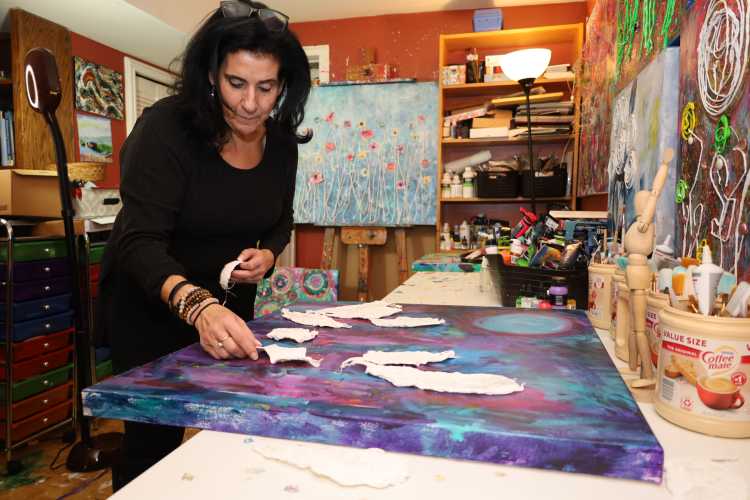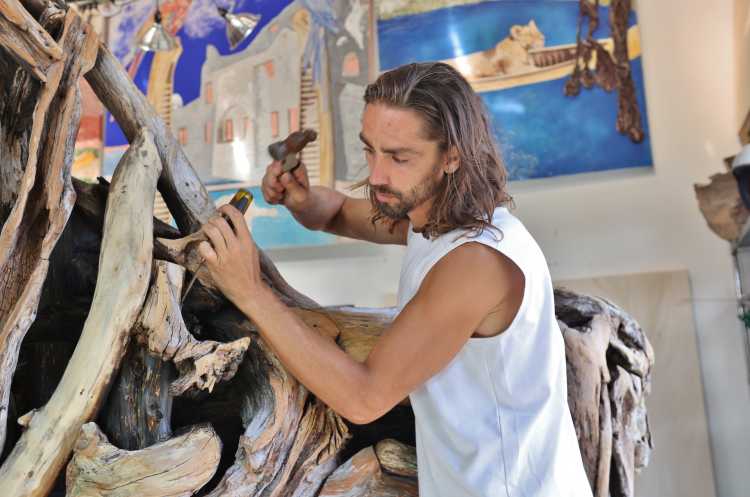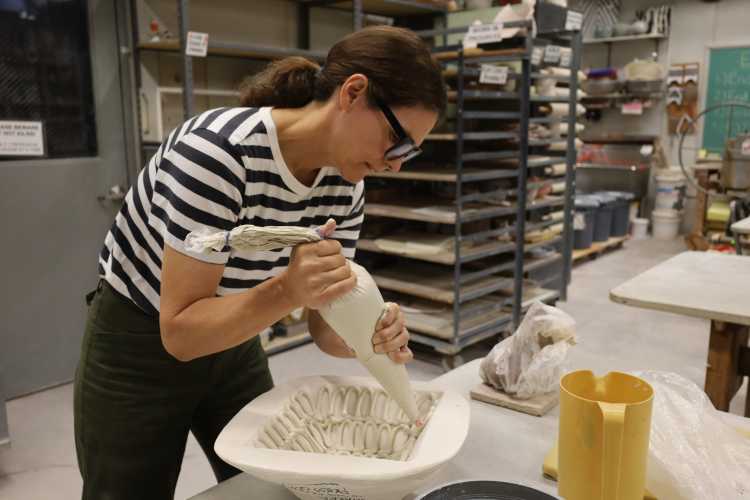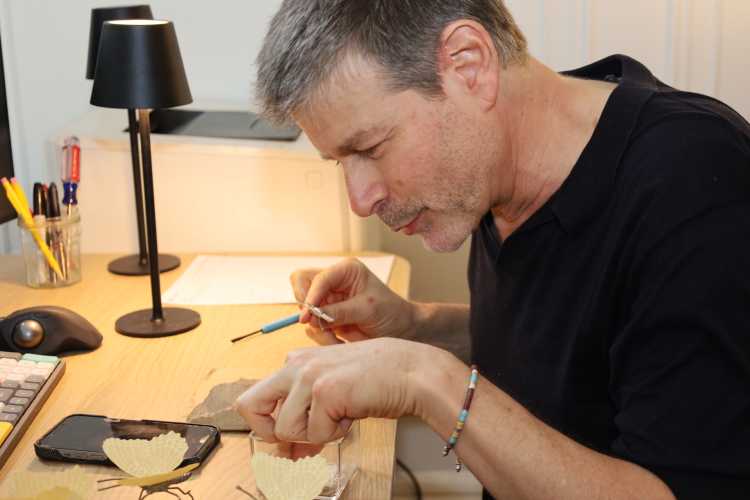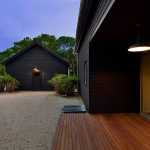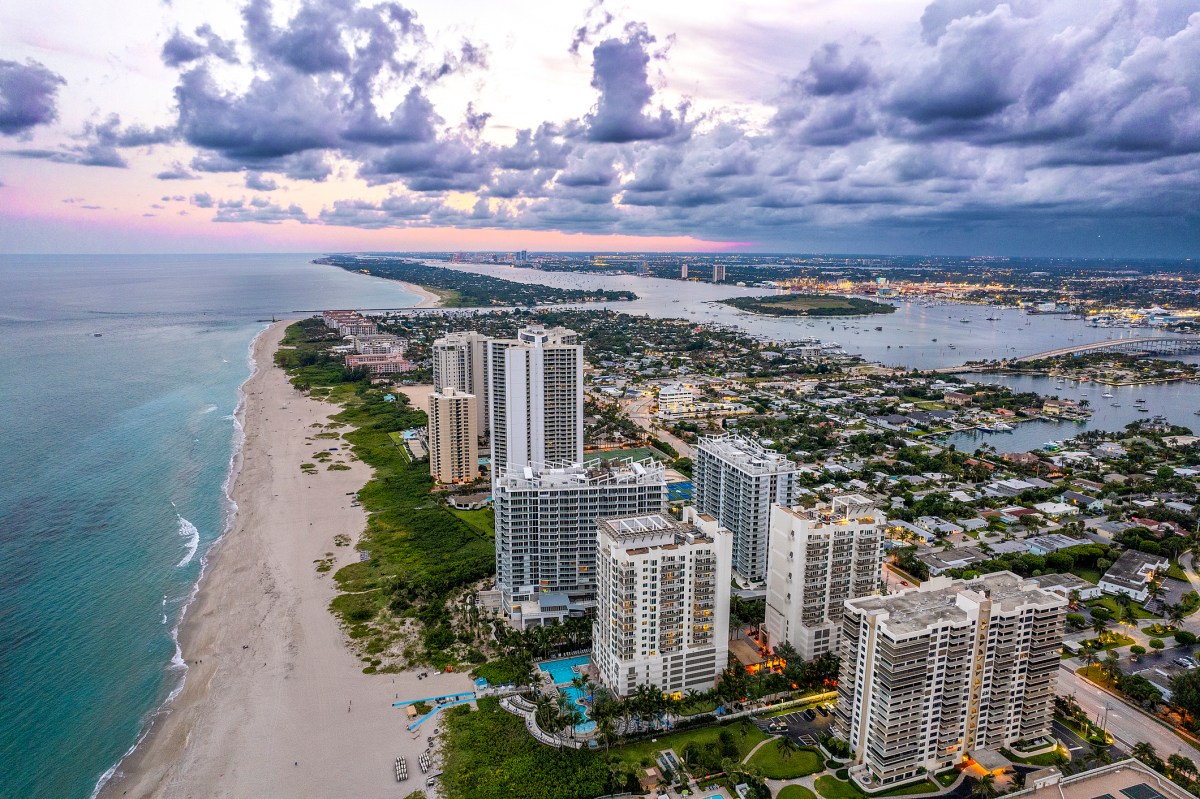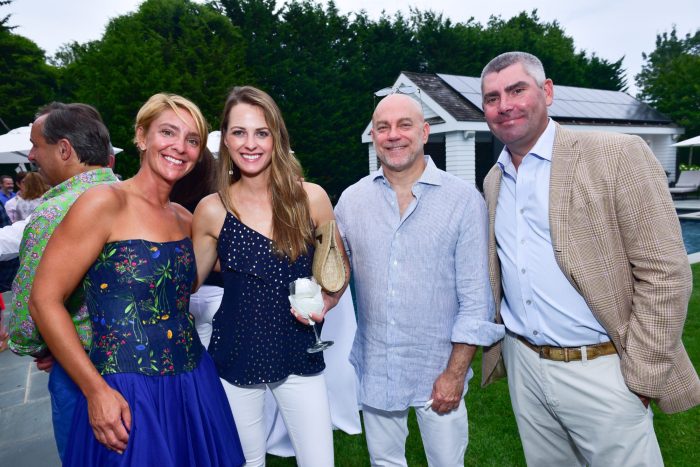On warmer days, when winter has withdrawn, Chris Hayes looks at his Bellmore backyard and sees more than 100 trees. Not a single one is planted in the ground. Instead, these often tiny trees are planted in pots, some rising only a few inches and others several feet.
Hayes is the proud owner and caretaker of about 150 bonsai plants at his home, mostly outdoors with a few tropical trees indoors. He is a practitioner of the craft of bonsai — part art, part nature and pleasure.
The co-owner of Long Island Bonsai Supply in Dix Hills, he also is the events coordinator for the Long Island Bonsai Society, a true believer and a craftsman who has taught classes in bonsai as well as giving advice at his store.
“I look out the window. It’s a very Zen, peaceful thing. It keeps me grounded and gives me time to think and be with nature,” Hayes says. “I’m a high-energy person. This calms me down.”
Bonsai practitioners talk about this as a craft where art meets gardening and a passion for nature meets the skill of tending to fragile gardens.
“Creating an aesthetically pleasing living artwork” is the way Hal Johnson, president of the Long Island Bonsai Society, describes bonsai. “You try to create a smaller-scale tree that looks like it’s older and bigger than it actually is.”
While looking at these miniature trees gives Hayes joy, he also gets pleasure from crafting and caring for them. “Every tree is different. You have to be good at watering, fertilizing, trimming,” Hayes says. “You have to repot them at the right time of the year.”
The Long Island Bonsai Society and the Bonsai Society of Greater New York are just two examples of bonsai resources for would-be enthusiasts.
“In the last two years, interest in bonsai has quadrupled,” Hayes adds. “I got started in the hobby 15 years ago. You couldn’t find material anywhere. It was hard to find anyone who knew about bonsai. Now it’s everywhere, online, Facebook groups.”
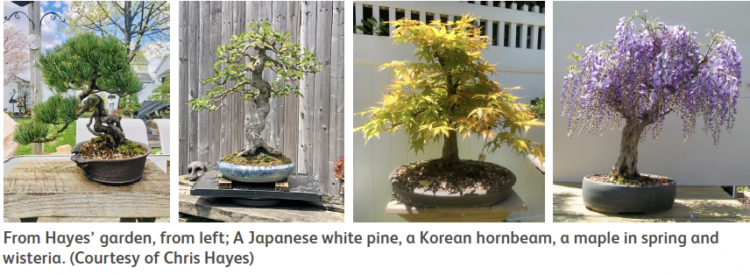
Beginning Bonsai
People who practice bonsai typically have a story story about how they discovered the craft. Hayes’ interest started about 15 years ago, largely by accident.
“A friend bought a little nothing tree they got at the mall and I really liked it,” Hayes says.
He had worked at a nursery and was interested in nature: Bonsai seemed like a perfect fit. “I always loved trees and plants,” Hayes says. “When I was introduced to bonsai, I thought, ‘These are like the giant trees I love in nature, but tiny.’”
Hayes studied, read up on bonsai and met bonsai masters who taught him. Today, he’s part of a bonsai community, culture and craft. “I like the more traditional bonsai style, like trees from nature,” he explains. “But I have other styles. You always find something you’re enamored of.”
Johnson worked as a microbiologist, dealing with living things, before discovering bonsai as a living work of art. “I’ve always worked with biological systems,” Johnson says. “I enjoy growing something and seeing it thrive.”
Tree Types
There are many ways to buy bonsai, including from other practitioners. “We trade trees, sell trees between us,” Hayes says of Long Island Bonsai Society members.
There also are bonsai stores, websites and ways to find them on Facebook, eBay, wholesale or other options. Stores like The Home Depot and mall kiosks often offer rudimentary options.
“You can get what we call malsai, a department store version of bonsai, at The Home Depot or local mall in a kiosk,” Hayes says. “Juniperus procumbens ‘nanas’ (garden junipers) are the most common on the lower end of the bonsai spectrum.”
Malsai (a mix of the word “mall” and “bonsai”) trees may not be as elaborate or elegant as higherend bonsai, but are one way to get into the hobby.
“They’re easy to take care of. It’s a beginner tree,” Hayes says. “There are limitations to trees like that. They’ll only look as good as that species will look.”
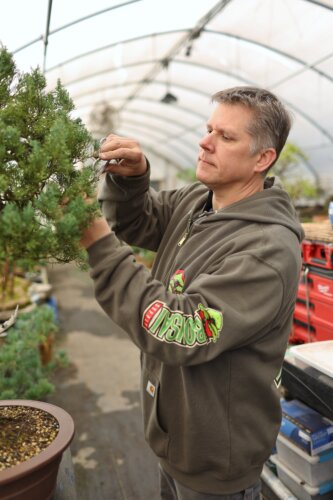
What’s In Store
While Hayes has his own sprawling bonsai collection at home, he also co-owns a bonsai store where he sells beginner, intermediate and high-end trees.
Hayes says beginner trees won’t break the bank, possibly costing $50, although they can be less or more. “If it dies on you, you won’t cry,” Hayes says. “It’s a good way to learn.”
Intermediate trees are slightly better and more expensive, while high-end trees cost up to $7,000 at his store. “You have to know what to do before you buy those trees,” Hayes says. Trident maples, he adds, are an example of sought-after, high-end trees.
“Some can look hundreds of years old,” Hayes says of high-end Japanese white pines, black pines, shimpaku junipers and others. “There’s more involved in taking care of them.”
Bonsai also can be divided into conifers, deciduous and tropical trees. Conifers are evergreens, while deciduous trees lose their leaves every fall. Tropical trees grow all year, and are usually kept indoors in this area, while other bonsai typically must be brought inside during winter.
“A lot of people choose tropical bonsai,” Hayes says. “The others go dormant in winter and need to be stored.”
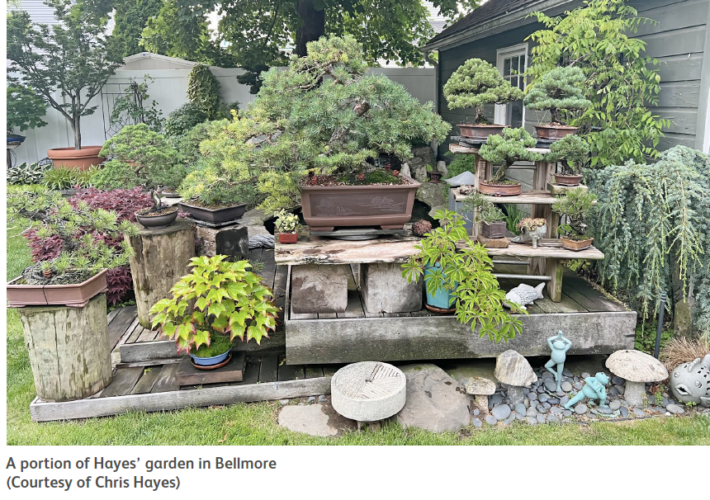
Style is substance
A big part of bonsai is styling, using wires to shape branches. “You take a raw piece of material and alter it to your liking,” Hayes says. “You style the tree like a hair stylist styles your hair.”
There are different approaches bonsai artists can take while shaping trees with wires. Windswept bonsai are shaped so their branches seem to be in a perpetual gust. “It looks like it’s being blown over by the wind,” Hayes says. “It almost looks animated.”
In cascade trees, instead of shaping them to grow vertically, you let trees grow out and down the sides of pots. “Think of a waterfall cascading down the rocks,” Hayes says. A semi-cascade tree may cascade half the distance down.
Traditional bonsai include vertical trees, creating maximum impact from a minimum tree that can look hundreds of years old.
“Some people have the ability to see what a tree can be, but some people don’t,” Hayes says. “That’s fine. You buy them already styled and love them the same.”
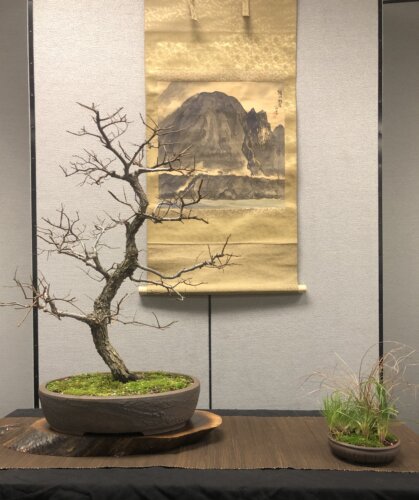
Caring for Bonsai
Bonsai trees can be as delicate as they look, requiring care and knowledge. Watering is no easy chore. “You’re always learning how to water in bonsai,”
Hayes says. “Watering is one of the hardest aspects of the hobby. It’s easy to under-water or overwater your tree.” Pines don’t need to be watered constantly, while a maple might need more.
You can pick the soil based on how much you plan to water, using a drier mix if you feel you water too much or a mix that retains more water, if you worry you might not water enough.
While a bonsai may look beautiful, Hayes says continuing care is crucial. “You’re always altering your tree,” he says. “We call certain trees finished, but they never really are finished. It’s always growing, changing.”
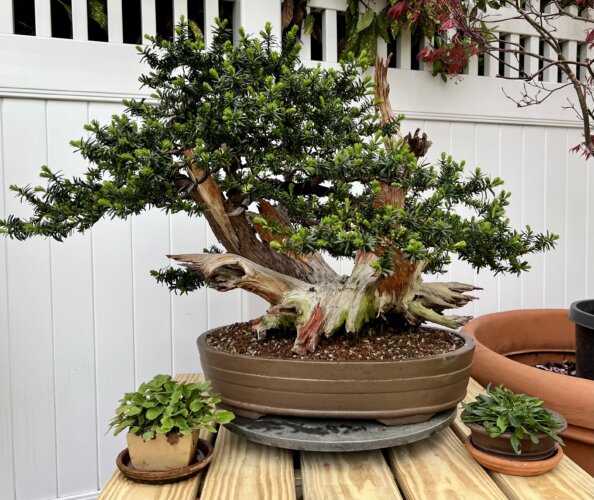
Potting power
Proper potting is a big part of the trick. Some trees require repotting annually, while others only need it every five years. “As long as you do the repotting at the right time of year, you’re fine,” Hayes says.
You repot for root growth, to prevent roots from encircling pots and choking trees. To keep a tree in its small state, you also must prune roots, cutting back and letting them grow at the right time. “If you let them get root-bound, the tree will dry itself out,” says Hayes.
You may repot as a tree grows slightly bigger or for aesthetic reasons, because you found a pot you prefer. “The pots are a whole other aspect of the hobby,” Hayes says. “Some pots are a couple of dollars. Some are thousands of dollars.”
Soil Story
Selecting or creating the right soil for your bonsai is also part of the craft. “There are lots of opinions on bonsai soil,” Hayes says. “It’s a very interesting topic.”
He uses the same soil used in Japan, including volcanic material, lava, pumice and akadama.
“They all have different characteristics related to how they retain water,” Hayes says.
Mixtures are made with different ratios depending on trees, Hayes adds. Getting the soil right can make it easier, or more difficult, to care for trees.
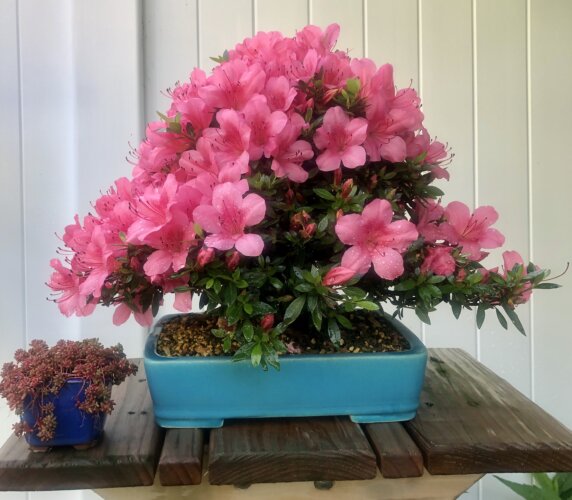
Learning
You can shape your bonsai, hire bonsai artists or buy bonsai already shaped like small sculptures.
“I’ve been fortunate enough to meet and become friends with a lot of high-end bonsai artists,” Hayes says. “They see what the tree can be.”
Regardless of what approach you take, you may want to take classes with accomplished bonsai artists, or go to bonsai club meetings and/or lectures and demonstrations.
“If you want to pursue bonsai, go somewhere, look at trees, decide what you like and ask questions,”
Hayes says. “Find what you like. Start talking to that person. Then join a club.”
Fellow enthusiasts can share expertise and enthusiasm. “The people in the club, I’ve found, can be very helpful,” Hayes says. “Everybody loves this hobby and wants to share.”
Free lecture demonstrations often let people watch practitioners at work. “See an artist transform what basically looks like a shrub to something that looks like a thousand-year-old tree,” Hayes says. “It’s amazing to watch someone go through the process.”
More time at home, including telecommuting, is translating into growing interest in bonsai. “Perhaps people are staying closer to home after the pandemic,” Johnson says. “That lifestyle shift has gratefully accommodated bonsai.”
Hayes has three small, tropical bonsai plants indoors in addition to his outdoor collection, which he puts in a greenhouse and garage during colder months. He’s happy to bid farewell to sold trees, but also enjoys looking at them while they’re for sale.
“I have a lot of material there that may or may not sell right away,” Hayes says of his store. “I get to enjoy it while it’s with me.”
He loves seeing the trees in different seasons. Normally, trees are green, but in spring, arriving now, some flower like azaleas bloom with colors displayed like brief, blazing, floral fireworks.
“In the fall, the leaves on a lot of deciduous trees change color,” Hayes says. “Some maples turn red, others turn yellow, orange, golden. Some are quite magnificent to see when they change. A lot of people collect them to see them at those times of the year.”
Azaleas can yield beautiful flowers and maples can be colorful, while pines and junipers, more traditional bonsai, are green. One thing is clear: bonsai lovers these days have more company when it comes to appreciating and learning the art and craft.
Hayes wears a bonsai jacket that these days attracts comments from fellow enthusiasts. “They say they love bonsai and have a collection,” Hayes says.
“I’m experiencing that more. The hobby’s on the upswing. It’s more accessible.”
The Long Island Bonsai Society meets monthly, typically the second Monday of the month, at the Planting Fields greenhouse classroom, 1395 Planting Fields Rd., Oyster Bay. Doors open at 7 p.m. for meetings starting at 7:25 p.m. First meeting is free. Annual fee, $45 and $65 per couple. For schedule updates, see longislandbonsai.org.
This article appeared in the April issue of Behind The Hedges Powered by the Long Island Press. Read the full digital edition here.


